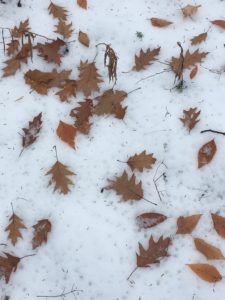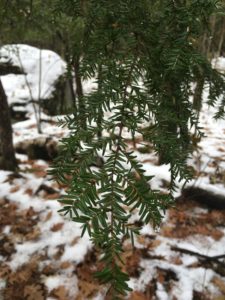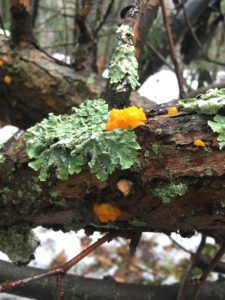






Google Maps Link: https://goo.gl/maps/np9vQxQmVvz
November
Winter’s Arrival
Though it’s not yet winter in the calendar, the first snow marks the start of the cold, dark, and often dreary season in Vermont. Within the last week, a carpet of white has transformed the land, covering the autumn leaves and small plants that populate the forest floor. All the leaves are gone from the trees, with stubborn buckthorn, beech, and oak the last to fall. The only colors in the forest come from the hemlock trees that populate this part of the forest. All around the spot are large rocks topped with rich green moss and covered with individual blankets of white. The path is trodden down with footprints, mostly people and their dog companions, but also raccoons, foxes, and deer. Chickadees perch among the bare branches of the deciduous trees. The forest in winter is quiet, like the whole land is holding its breath. But it is not inactive. Overripe berries and dropped seeds feed birds like chickadees, cardinals, and blue jays, all year-round residents in Vermont. Prints in the snow mark the travels of small mammals, many of whom have donned winter coats for the colder temperatures. Today, a steady drip of rain has begun to melt some of the snow. The snow may be receding, but it will soon be back as another Vermont winter begins in earnest.

A Closer Look: Forest Succession
Neither the Burlington nor the Shelburne forest phenology sites are close to being old-growth forests, but they are at very different stages. In Burlington, mature sugar maples dominate. The undergrowth is populated by elm, ash, and buckthorn. There are very few conifers found in this stretch of forest. When the leaves are out, the canopy cover reaches about 85%, and with leaves fallen it is about 60%. Though this site is not a mature, it is well into the understory reinitiation phase, which is to say that it is a two-age forest. In contrast, the Shelburne site is populated by buckthorn, black cherry, hemlock, and a few larger oaks. Without leaves, the canopy cover is about 35%, but with leaves it could reach about 60%. This site is in a much earlier stage of development; with a few exceptions, all of the trees are about the same age and this forest is likely in the stand initiation phase, characterized by sunlight and space, as well as shade intolerant trees like black cherry.
